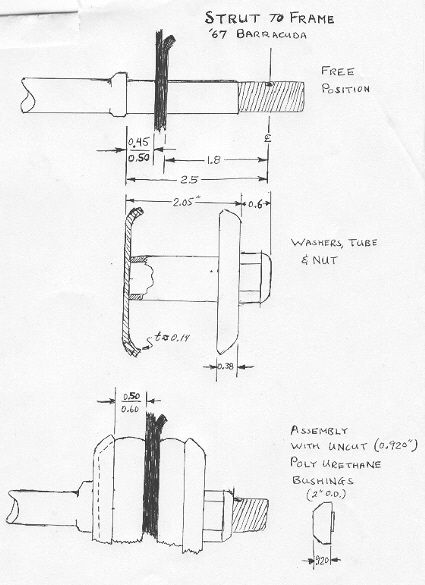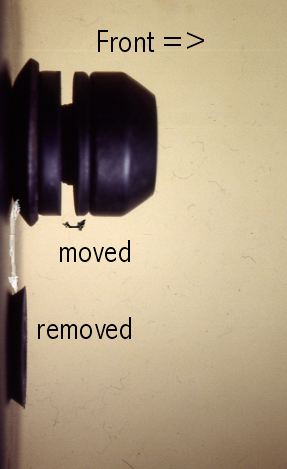Making A-Body Strut Bushings Work
or, How to get replacement bushings not push the lower control arm back

The original Mopar strut bushings had a thicker and thinner
section (right photo). If this is not done the lower control arm is pushed back causing
it to slip on its pivot bushing if polurethane, and/or causing undue wear
and reducing caster in either rubber or poly.*
To obtain the thin rear section on a strut rod bushing, it appears
one could buy the "Moog Improved", or one can modify a standard polyurathane
(or rubber) A/E body set as shown below.
Note: there was also a one piece rubber bushing that originally
came on most if not all a-bodies. It wasn't much fun to remove, and apparently
was not used as the prefered replacement even by Mopar.
 |
Top Drawing - Strut Position in K-Frame:
Reaction strut installed without the front bushing assembly.
to determine The frame thickness and space available for bushings on each side of the frame was measured.
Middle Drawing - Strut Bushing Assembly Hardware:
The washer and tube assembly that came with the poly bushings was measured. The overall length including the nut is 2.65", so 0.15+" will compress (tube into the washers).
Bottom Drawing - Unmodified Poly Bushing Installed:
Installed and tightened to spec. with the 0.920" thick bushings, the strut rod was pushed back. Measurements with clay found the strut rod shoulder was 0.88" from the frame (minimum). (Bushing showing measured 0.50" + washer measured in the drawing
above 0.38").
Conclusion:
Since the distance from frame to the strut
shoulder should only be 0.45 to 0.50"(top drawing), but with the replacement bushings it was at least 0.88". Therefore a total of 0.38 to 0.53" needed to be removed from the back bushing. |
 It seemed important to keep some of the cone shape for good assembly fit. As these parts were clearly not engineered specifically for the A-bodies, whether all the extra thickness was really needed is not known. My
decision from several trials was no. So, about half the thickness to be removed was sliced off the cone side and half off of the full diameter side. It seemed important to keep some of the cone shape for good assembly fit. As these parts were clearly not engineered specifically for the A-bodies, whether all the extra thickness was really needed is not known. My
decision from several trials was no. So, about half the thickness to be removed was sliced off the cone side and half off of the full diameter side. |
 The full diameter part
was moved to the front half of the assembly. Also some of the original
shoulder was sliced and that was saved for the spacing through
the frame if it was needed. The full diameter part
was moved to the front half of the assembly. Also some of the original
shoulder was sliced and that was saved for the spacing through
the frame if it was needed. |
* A lower control arm being pushed off a nylon bushing from a too thick strut bushing can be seen at www.Firmfeel.com. They offer an adjustable strut rod as an alternative way to get the same results I did.
Home:'67 Barracuda..one
curve to another
More Tech:
Fuel Delivery Facts and Figures
Improving Forward Lighting & Electricals
Ignition Wire Comparison
Handling Theory for late-'60s to mid-'70s Mopars
Disclaimer:
If you take advice, or copy something I have done,
you are on your own. I'm just trying to be helpful. You need to make
your own decisions, and know about or discover the risks before barging
ahead on any endevour.
e-mail
copyright Mathew Grubel, December 10, 2003
2nd edition. February 28, 2004

 It seemed important to keep some of the cone shape for good assembly fit. As these parts were clearly not engineered specifically for the A-bodies, whether all the extra thickness was really needed is not known. My
decision from several trials was no. So, about half the thickness to be removed was sliced off the cone side and half off of the full diameter side.
It seemed important to keep some of the cone shape for good assembly fit. As these parts were clearly not engineered specifically for the A-bodies, whether all the extra thickness was really needed is not known. My
decision from several trials was no. So, about half the thickness to be removed was sliced off the cone side and half off of the full diameter side.  The full diameter part
was moved to the front half of the assembly. Also some of the original
shoulder was sliced and that was saved for the spacing through
the frame if it was needed.
The full diameter part
was moved to the front half of the assembly. Also some of the original
shoulder was sliced and that was saved for the spacing through
the frame if it was needed.